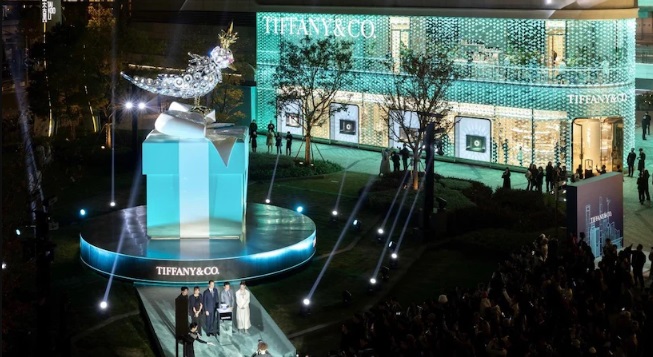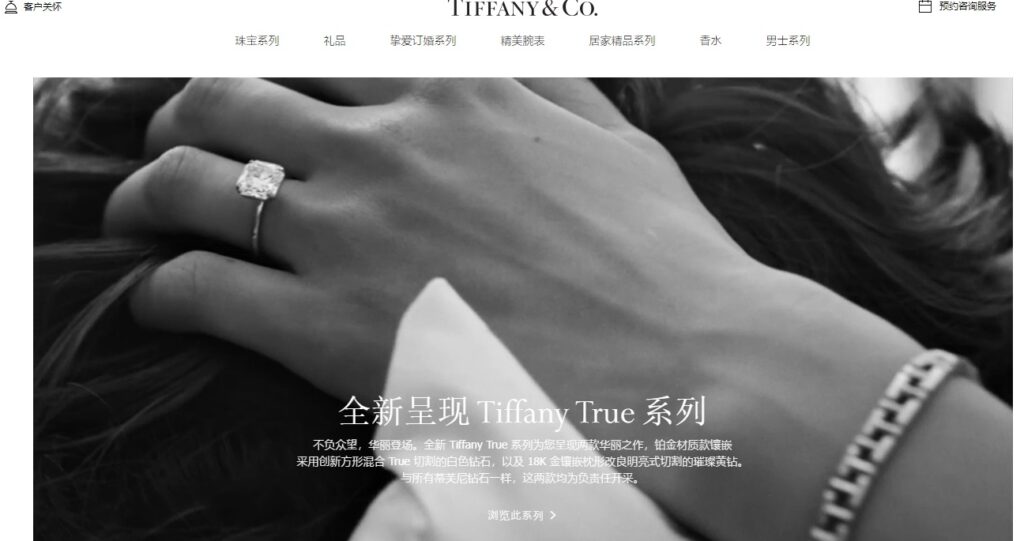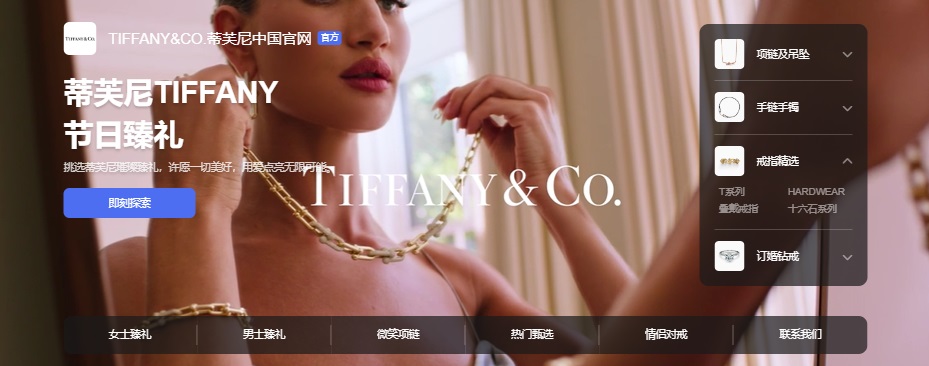Once upon a time, in the bustling markets of China, a gleaming beacon of luxury and elegance emerged – Tiffany & Co. This iconic jeweler, renowned for its exquisite craftsmanship and timeless designs, embarked on a journey to captivate the hearts of China’s affluent shoppers.
The Story of Tiffany in China
As Tiffany’s blue boxes began appearing in the chicest locales, from Shanghai’s glittering towers to Beijing’s historic avenues, a story of glamour, innovation, and cultural fusion unfolded. Each store, a palace of dreams, where sparkling diamonds and lustrous pearls whispered tales of love and celebration.
Tiffany’s tale in China is not just about jewelry; it’s a narrative of adapting to a vibrant culture, understanding the nuances of Chinese preferences, and weaving the brand’s rich heritage into the fabric of China’s luxury landscape. It’s a story that continues to evolve, shining brighter with each passing day.
Tiffany & Co.’s Taikoo Li Qiantan Store
Shanghai witnessed a dazzling start to its festive season on December 8, as Tiffany & Co., the renowned luxury jeweler, illuminated the city with a grand holiday lighting event.
- This sparkling celebration marked the opening of their latest store at Taikoo Li Qiantan,
- adding a touch of glamour to the city’s vibrant landscape.
- The event was graced by an array of VIPs, including the face of Tiffany in China, actor Greg Hsu, and the dynamic young entrepreneur Laurinda Ho.
Joining them were Maxence Kinget, President of Tiffany & Co. Greater China, Andrew Wu, President of LVMH Group Greater China, and Joanna Ku, General Manager of Taikoo Li Qiantan. source JIngdaily

A highlight of the ceremony was a stunning lighting display, anchored by a monumental Tiffany Blue Box. This installation was crowned with a glittering bird sculpture, nodding to Jean Schlumberger’s iconic Bird on a Rock piece, and symbolizing Tiffany’s illustrious heritage.
Echoing the revamped design of its flagship store in New York, The Landmark, Tiffany’s new location in China — its 40th on the mainland — offers an elevated shopping experience. The store’s exterior, adorned with 6,988 shimmering ‘diamonds,’ leads into an interior space that merges artistic design with exquisite craftsmanship, creating a cultural destination that celebrates innovation.
Each floor of the store features a private salon, adorned with floral wallpaper that pays homage to Tiffany’s rich history. These salons offer exclusive consultation services for VIP clients.
Since its acquisition by LVMH in 2021, Tiffany & Co. has identified China as a key driver in its global expansion strategy. The brand has seen a significant surge in sales, leaping from $3.2 billion (3 billion euros) in 2020 to $5.5 billion (5.1 billion euros) in 2022. This upward trajectory is expected to continue, with projections setting sales to reach $8 billion (7.4 billion euros) by 2025. Notably, the brand’s high jewelry revenue doubled in 2022, underlining its growing prominence in China’s lucrative luxury market.

10 Facts About Tiffany & Co. in China
- First Store Opening: Tiffany’s first foray into China was in 2001, marking the beginning of its journey in the Asian market.
- Rapid Expansion: As of 2024, Tiffany boasts over 40 stores across mainland China.
- Cultural Collaborations: Tiffany has collaborated with renowned Chinese artists and celebrities to resonate with local audiences.
- Customized Collections: Exclusive collections have been designed specifically for the Chinese market.
- Huge E-Commerce Presence: Tiffany has a strong online presence in China, utilizing platforms like Tmall to reach a wider audience.
- Positioning: The brand emphasizes sustainable practices, resonating with the growing eco-consciousness among Chinese consumers.
- Local Festivities: Tiffany creates special campaigns around Chinese festivals like Lunar New Year and Singles’ Day.
- Celebrity & KOL: High-profile Chinese celebrities have been brand ambassadors, amplifying Tiffany’s appeal.
- Bridal Market Penetration: The brand has tapped into China’s lucrative bridal market with bespoke engagement and wedding ring designs.
- Rising Sales Figures: Tiffany’s sales in China have seen a significant increase, especially in the high jewelry segment.

In the opulent tapestry of China’s luxury landscape, the jewelry market emerges as a dazzling gem, reflecting the nation’s flourishing economic prowess and the sophisticated tastes of its burgeoning affluent class. This realm, where tradition waltzes with modernity, is marked by an insatiable desire for high-end, exquisite jewelry pieces. The Chinese market, steeped in a rich heritage, venerates gold and jade as emblems of prosperity and social esteem. Yet, there’s a palpable shift towards the allure of diamonds and vibrant gemstones, a nod to the growing influence of Western elegance and refinement.
This expansion of luxury is not confined to the grandeur of megacities like Beijing and Shanghai; it’s a phenomenon that’s radiating its brilliance into the heart of smaller urban landscapes. The digital age has further polished this sector, with sophisticated e-commerce platforms and the influential reach of social media reshaping the contours of consumer engagement and preferences. The future of China’s jewelry market glimmers with promise, a luxurious blend of ancestral legacies, contemporary opulence, and cutting-edge digital sophistication, crafting a narrative of unparalleled luxury and style.
10 Tips for Selling Jewelry in China: Digital Marketing Strategies
- Leverage Social Media Platforms: Utilize WeChat and Weibo for brand storytelling and customer engagement. read more
- Engage with KOLs (Key Opinion Leaders): Collaborate with influential figures to increase brand visibility and credibility.
- Utilize Live Streaming: Host live streaming sessions on platforms like Taobao Live to showcase collections and interact with consumers.
- Invest in SEO and SEM: Optimize for Baidu to enhance online visibility in China.
- Create Culturally Relevant Content: Tailor your marketing content to align with Chinese culture and values.
- Mobile-First Approach: Focus on mobile-friendly content and e-commerce experiences, considering the high mobile usage in China.
- Online-to-Offline (O2O) Experiences: Blend online marketing with unique offline experiences in stores.
- Loyalty Programs: Develop loyalty programs that reward repeat customers and encourage word-of-mouth.
- Localized E-Commerce Platforms: Utilize popular Chinese e-commerce platforms like Tmall and JD.com for online sales.
- Data-Driven Marketing: Use consumer data and analytics to understand preferences and tailor marketing strategies.
In conclusion, Tiffany & Co.’s journey in China is a dazzling testament to the brand’s ability to intertwine its legacy with the evolving tastes of a dynamic market. By embracing digital marketing strategies and understanding the unique nuances of Chinese consumer behavior, jewelry brands can successfully sparkle in this vibrant marketplace.
Read more

